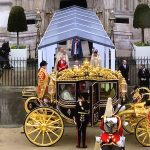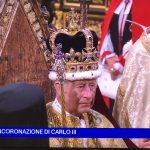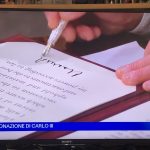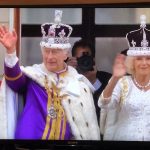Il 6 Maggio abbiamo assistito ad uno degli eventi più importanti che ha coinvolto non solo il popolo inglese, ma tutto il mondo. Immagino che ognuno di noi abbia almeno dato una sbirciatina all’evento d’Incoronazione di Re Carlo III. La cerimonia è iniziata con la processione che ha portato il futuro re da Buckingham Palace all’abbazia di Westminster; è stata scelta la Diamond Jubilee State Coach, una carrozza dorata, dotata di ogni comfort, fatta costruire dalla regina Elisabetta II nel 2014. Ad attenderli nell’abbazia, oltre ai membri della famiglia, c’erano capi di stato e di governo, artisti ed esponenti delle varie religioni. Carlo III ha voluto che la cerimonia fosse più snella rispetto al passato.
Per prima cosa, tradizione che risale all’epoca anglosassone, Carlo è stato presentato al “popolo”; poi l’Arcivescovo di Canterbury Justin Welby ha fatto il suo primo discorso seguito dalla Dama della Giarrettiera e dalla Dama del Cardo. Dal momento che il sovrano è chiamato a governare secondo coscienza nel nome di Dio al Re è stata presentata la Bibbia prima del Giuramento. Al re viene quindi tolta la veste cerimoniale e, protetto da un paravento perché è un momento intimo, è stato unto con l’olio consacrato a Gerusalemme e conservato in un’ampolla d’oro risalente al 1661.
A questo punto al Re, rivestito con le vesti ufficiali, sono state presentate le “regalia”, ossia i simboli del potere regale: il Globo d’oro del sovrano (in oro con incastonati smeraldi, rubini, zaffiri, diamanti e perle; diviso in tre segmenti in rappresentanza dei tre continenti che erano conosciuti in epoca medievale), l’anello dell’incoronazione (realizzato nel 1831 per Guglielmo IV dai gioiellieri Rundell, Bridge & Rundell ed ispirato alla bandiera del Regno Unito con i rubini a simboleggiare la croce di San Giorgio e lo zaffiro a richiamare la bandiera scozzese), lo scettro con la croce (creato nel 1661 in oro ha 333 diamanti, 31 rubini, 15 smeraldi, sette zaffiri e altre pietre preziose tra le quali la Grande Stella d’Africa, nota anche come Cullinan I, il più grande diamante a taglio netto del mondo) e quello con la colomba (realizzato in oro, diamanti rosa e una croce che sostiene una colomba smaltata con le ali spiegate, simbolo di giustizia e misericordia); gli speroni d’oro (realizzati nel 1661 il cui significato simbolico risale dall’epoca in cui il monarca cavalcava alla testa di un esercito, oggi rappresentano il coraggio e la volontà di difendere chi ha bisogno), la spada ingioiellata e altre quattro spade (la Spada di Stato, simbolo dell’autorità reale, la Spada della Giustizia Temporale, la Spada della Giustizia Spirituale e la Spada della Misericordia), i braccialetti d’oro (segno di sincerità e saggezza).
Infine l’arcivescovo ha posato la corona di Sant’Edoardo sulla sua testa mentre suonano le campane dell’abbazia e le trombe e i tutto il Regno sono stati sparati sparati colpi di arma da fuoco, 62 dalla Torre di Londra e una salve di sei cannoni dall’Horse Guards Parade. Questo è l’unico momento in cui il Re ha indossato la corona di Sant’Edoardo, realizzata nel 1611 in oro massiccio e decorata con rubini, ametiste, zaffiri, granati e topazi. Poi è stata indossata la Corona Imperiale realizzata nel 1937 per Giorgio VI, padre della regina Elisabetta II. E’ decorata con alcuni dei gioielli storici più importanti della storie inglese. Racchiude 2868 diamanti, 17 zaffiri, 11 smeraldi, 269 perle e 4 rubini; vi è incastonato lo zaffiro di Sant’Edoardo, appartenuto a Edoardo il confessore; vi sono quattro perle appartenute a Caterina de Medici e a Maria Stuart; troviamo il Rubino del principe Nero, il grande diamante Cullinan II, noto come Seconda stella d’Africa e lo zaffiro degli Stuart.
Il sovrano ha indossato prima la tradizionale Robe of State di ermellino realizzata per Giorgio VI nel 1937, caratterizzata da un lungo strascico color cremisi tenuto da paggi, tra questi il principino George. Durante la cerimonia ha indossato il Mantello Imperiale, una veste antica decorata con ricami floreali e simbolici che pesa oltre due chili e il guanto appartenuto al nonno, simbolo dell’onore del sovrano e del suo popolo. Alla fine ha messo la Robe of Estate in velluto di seta viola, anch’essa appartenuta a Giorgio VI.
Prima della fine della celebrazione Camilla è stata incoronata regina. Per l’occasione ha scelto un abito in seta a maniche lunghe di colore bianco e impreziosito da guizzi oro e argento, realizzato da Bruce Oldfield. Sull’orlo della sottogonna e sui polsini sono presenti altri emblemi floreali: la rosa, il narciso, il trifoglio e il cardo che rappresentano le quattro nazioni del Regno Unito e qualcosa di personale, come l’effige dei suoi due cani, Bluebell e Beth, oltre ai nomi dei suoi figli e nipoti. La corona fu realizzata da Garrard & Co. per la Regina Maria nel 1911; è rivestita d’oro con 2200 diamanti incastonati tra cui il Koh-i-Noor che è stato sostituito in quest’occasione da uno zircone per una diatriba ancora aperta con l’India.
Per il ritorno, nel tragitto dall’Abbazia di Westminster a Buckingham Palace è stata usata la Gold State Coach, la carrozza dorata usata per la prima volta da Giorgio III per recarsi all’apertura del Parlamento nel 1762.
Molti degli occhi erano puntati, inevitabilmente, sulla più ammirata dalla Royal Family, la principessa Catherine di Galles la quale, sotto il mantello dell’Ordine della Giarrettiera, ha indossato un abito bianco lungo e bianco in crêpe di seta firmato Alexander McQueen con con ricami ton su ton. Sui capelli ha messo una coroncina in oro bianco tempestati di diamanti creata appositamente per l’occasione da Jess Collett x Alexander McQueen e come orecchini i pendenti di perle e diamanti di Annoushka Ducas appartenuti a Lady Diana. La piccola Charlotte per essere in armonia con la mamma ha indossato un abito Bianco, una cappa e un prezioso cerchietto floreale.
On the 6th of May we witnessed one of the most important events that involved not only the British people, but the whole world. Each of us at least took a peek at the coronation event of King Charles III. The ceremony began with the procession that carried the future king from Buckingham Palace to Westminster Abbey; the Diamond Jubilee State Coach was chosen, a golden carriage, equipped with every comfort, built by Queen Elizabeth II in 2014. Waiting for them in the abbey, in addition to family members, were heads of state and government, artists and exponents of various religions. Charles III wanted the ceremony to be more streamlined than in the past. First of all, a tradition that dates back to the Anglo-Saxon era, Charles was presented to the “people”; then the Archbishop of Canterbury, Justin Welby, has spoken followed by the Garter Dame and the Thistle Dame. Since the sovereign is called to rule according to conscience in the name of God, the Bible was presented before the Oath. The king is then removed the ceremonial robe and, protected by a screen because it is an intimate moment, was anointed with oil consecrated in Jerusalem and kept in a gold ampoule dating back to 1661. After the King, dressed in official clothes, were presented with the “regalia”, the symbols of royal power: the golden globe of the sovereign (in gold with emerald, rubies, sapphires, diamonds and pearls; divided into three segments representing the three continents that were known in medieval times), the coronation ring (made in 1831 for William IV by the jewelers Rundell, Bridge & Rundell and inspired by the flag of the United Kingdom with rubies to symbolize the cross of St. George and the sapphire to recall the Scottish flag), the scepter with the cross (created in 1661 in gold with 333 diamonds, 31 rubies, 15 emeralds, seven sapphires and other precious stones including the Great Star of Africa, also known as Cullinan I, the largest clean-cut diamond in the world) and the one with the dove (made of gold, pink diamonds and a cross supporting an enamelled dove with spread wings, symbol of justice and mercy); the golden spurs (made in 1661 whose symbolic meaning dates back to the time when the monarch rode at the head of an army, today represent the courage and will to defend those in need), the jeweled sword and four other swords (the Sword of State, symbol of royal authority, the Sword of Temporal Justice, the Sword of Spiritual Justice and the Sword of Mercy), gold bracelets (sign of sincerity and wisdom). Finally the Archbishop placed the crown of St. Edward on his head while the abbey bells and trumpets rang and the whole Kingdom were fired shots, 62 from the Tower of London and a salvo of six cannons from the Horse Guards Parade. This is the only time when the King wore the crown of St. Edward, made in 1611 of gold and decorated with rubies, amethysts, sapphires, garnets and topazes. Then he wore the Imperial Crown made in 1937 for George VI, father of Queen Elizabeth II. It is decorated with some of the most important historical English jewels. It has 2868 diamonds, 17 sapphires, 11 emeralds, 269 pearls and 4 rubies; there is set the sapphire of St. Edward, which belonged to Edward the Confessor; there are four pearls that belonged to Catherine de Medici and Mary Stuart; there are the Ruby of the Black Prince, the great diamond Cullinan II, known as the Second Star of Africa and the sapphire of the Stuart. The King wore before the traditional ermine Robe of State made for George VI in 1937, characterized by a long crimson train held by pages, including Prince George. During the ceremony he wore the Imperial Cloak, an antique robe decorated with floral and symbolic embroidery that weighs over two kilos and the glove that belonged to her grandfather, a symbol of the honor of the sovereign and his people. At the end The King put the Robe of Estate in purple silk velvet, which also belonged to George VI. Before the end of the celebration, Camilla was crowned queen. For the occasion she chose a silk white dress with long sleeves and embellished with gold and silver flashes, made by Bruce Oldfield. On the hem of the petticoat and cuffs are other floral emblems: the rose, narcissus, clover and thistle representing the four nations of the United Kingdom and something personal, such as the effigy of her two dogs, Bluebell and Beth, as well as the names of her children and grandchildren. The crown was made by Garrard & Co. for Queen Mary in 1911; it is a gold crown with 2200 diamonds set including the Koh-i-Noor which was replaced on this occasion by a zircon for a still open dispute with India. On the way back, from Westminster Abbey to Buckingham Palace, the Gold State Coach was used, the golden carriage used for the first time by George III to go to the opening of Parliament in 1762. Many of the eyes were inevitably focused on the most admired person in the Royal Family, Princess Catherine of Wales who, under the mantle of the Order of the Garter, wore a long white and white dress in silk crêpe created by Alexander McQueen with ton on ton embroidery. On her hair she put a white gold crown studded with diamonds created especially for the occasion by Jess Collett x Alexander McQueen and as earrings the pearl and diamond pendants by Annoushka Ducas that belonged to Lady Diana. Little Charlotte wore a white dress, a cape and a precious floral fascinator to be in harmony with her mother wore.






